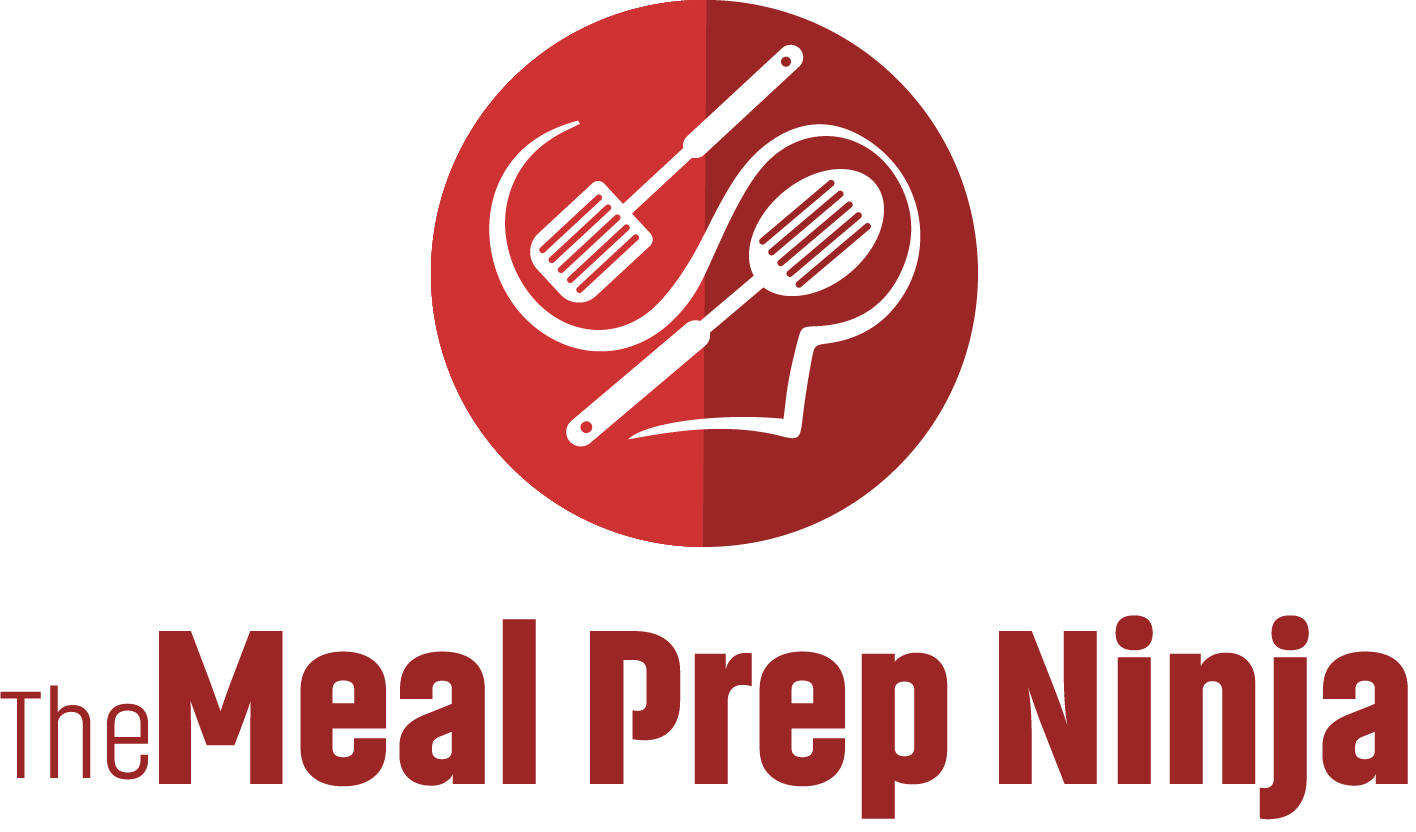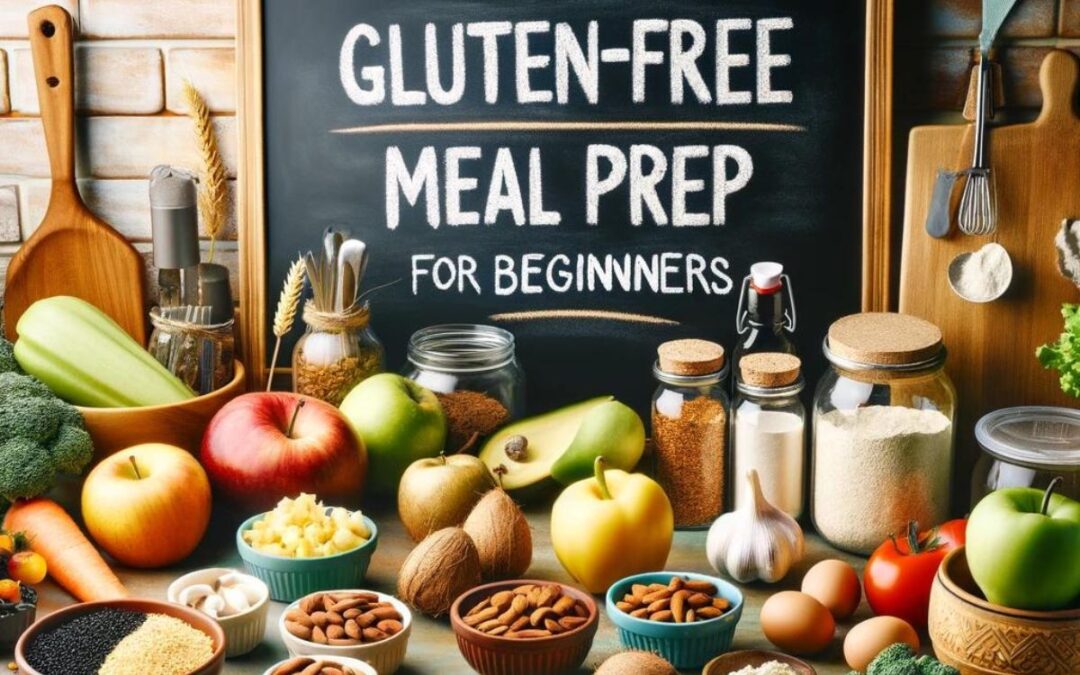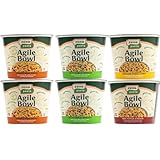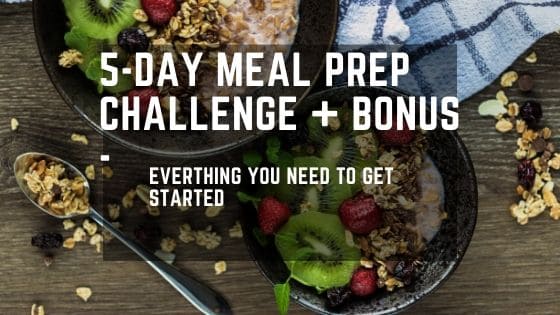Last Updated on February 25, 2024 by TheMealPrepNinja
Welcome to my gluten-free meal prep guide for beginners! If you’re new to the world of gluten-free eating and looking to make meal planning easier, you’ve come to the right place. In this guide, I’ll walk you through the essentials of gluten-free meal prep, provide tips on navigating gluten intolerance and celiac disease, and share delicious recipes that are beginner-friendly.
Following a gluten-free diet doesn’t have to be complicated or restrictive. With a little planning and organization, you can enjoy easy and nutritious meals that support your dietary needs. Whether you’re gluten intolerant, have celiac disease, or simply want to explore gluten-free options, this guide will help you get started.
In the sections below, you’ll find information on understanding gluten-free meal planning, setting up a gluten-free kitchen, and creating a balanced gluten-free diet plan. I’ll also share tips on gluten-free baking, preventing burnout with varied meal ideas, and meal solutions for those with dairy restrictions as well.
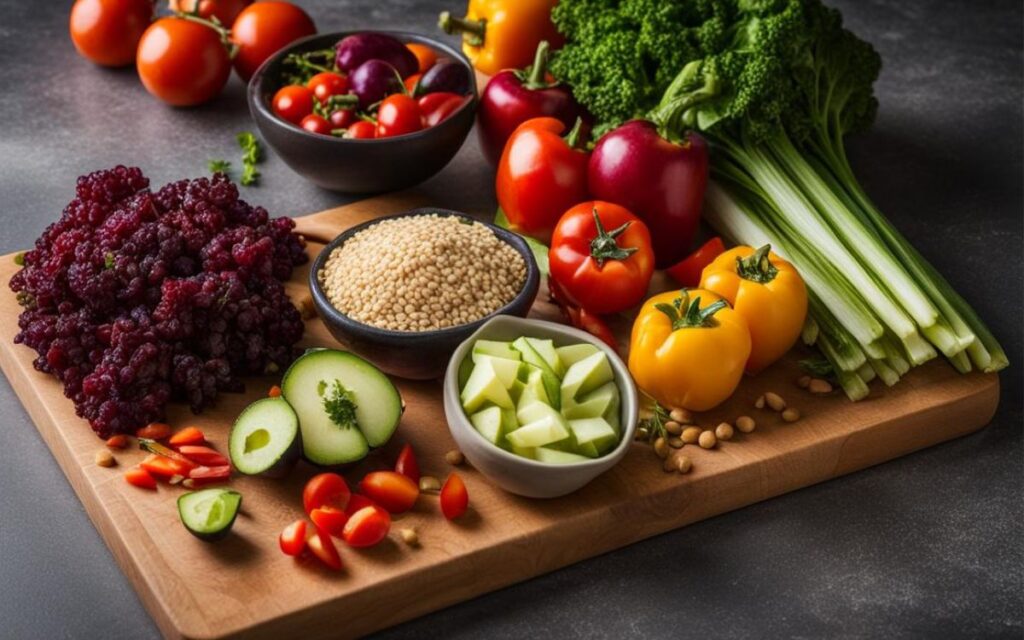
Key Takeaways:
- Gluten-free meal prep can make eating a gluten-free diet easier and more convenient.
- Understanding the basics of a gluten-free diet and the benefits of meal planning is essential for beginners.
- Setting up a gluten-free kitchen and preventing cross-contamination are crucial for staying safe and healthy.
- Meal prepping can save time, money, and ensure you always have delicious gluten-free meals on hand.
- Experimenting with different ingredients and exploring global cuisines can help prevent meal prep burnout and add variety to your gluten-free diet.
Understanding Gluten-Free Meal Planning
Gluten-free meal planning is an essential aspect of maintaining a healthy and enjoyable gluten-free diet. In this section, I will provide a comprehensive overview of gluten-free meal planning and its significance for individuals with gluten intolerance or celiac disease.
What is a Gluten-Free Diet?
A gluten-free diet involves avoiding the protein called gluten, which is found in grains such as wheat, barley, and rye. By eliminating gluten-containing foods from their diet, individuals with gluten intolerance or celiac disease can manage their symptoms and promote overall well-being.
Benefits of Gluten-Free Meal Planning
Gluten-free meal planning offers numerous benefits, including improved digestive health, increased energy levels, and better nutrient absorption. It allows individuals to explore a wide range of gluten-free ingredients and experiment with new flavors and textures. By planning meals in advance, individuals can ensure they have nutritious and delicious gluten-free options readily available.
Navigating Gluten Intolerance and Celiac Disease
For those new to a gluten-free diet, understanding how to navigate gluten intolerance and celiac disease can be challenging. It is vital to educate oneself about hidden sources of gluten, cross-contamination risks, and safe gluten-free alternatives.
By following proper guidelines and seeking support from healthcare professionals and trusted resources, individuals can successfully manage their gluten-free diet and create celiac-friendly meals.
Essentials of a Gluten-Free Kitchen
In order to successfully navigate a gluten-free lifestyle, it is important to have a well-equipped kitchen that supports your dietary needs. Setting up a gluten-free pantry and taking measures to prevent cross-contamination are essential steps to ensure the safety and deliciousness of your gluten-free meals.
Additionally, incorporating gluten-free grains into your cooking can add variety and nutrition to your gluten-free meal prep routine.
Setting Up Your Gluten-Free Pantry
Creating a gluten-free pantry starts with carefully selecting gluten-free ingredients. Look for products labeled “gluten-free,” as they have been tested to meet gluten-free standards. Here are some essential pantry items to stock up on:
- Gluten-free flours (such as rice flour, almond flour, or tapioca flour)
- Gluten-free baking mixes
- Gluten-free pasta and noodles
- Gluten-free bread and wraps
- Gluten-free sauces and condiments (check labels for hidden gluten)
- Gluten-free grains (such as quinoa, millet, or buckwheat)
- Gluten-free snacks and treats
By having these gluten-free pantry staples on hand, you’ll always be prepared to whip up a delicious gluten-free meal.
Cross-Contamination Prevention Tips
One of the biggest challenges of maintaining a gluten-free kitchen is preventing cross-contamination. Even a small amount of gluten can cause a strong reaction in individuals with gluten intolerance or celiac disease. Here are some tips to prevent cross-contamination:
- Designate a separate area for gluten-free food preparation.
- Use separate cutting boards, utensils, and cookware for gluten-free cooking.
- Clean countertops, appliances, and utensils thoroughly before preparing gluten-free meals.
- Avoid using shared condiments that may have come into contact with gluten.
- Be cautious when dining out or eating at a friend’s house, as cross-contamination is common in these settings.
By following these cross-contamination prevention tips, you can ensure that your gluten-free meals remain safe and free from gluten contamination.
Gluten-Free Grains
Gluten-free grains are an excellent addition to any gluten-free pantry. Not only do they provide a source of carbohydrates, fiber, and nutrients, but they also add texture and flavor to your meals. Here are some popular gluten-free grains and their uses:
| Gluten-Free Grain | Uses |
|---|---|
| Quinoa | Salads, soups, stir-fries, pilafs |
| Millet | Porridge, baked goods, side dishes |
| Buckwheat | Gluten-free pancakes, soba noodles, porridge |
| Amaranth | Baked goods, porridge, salads |
By incorporating these gluten-free grains into your meal prep, you can enjoy a wide range of flavors and textures while adhering to your gluten-free diet.
Gluten-Free Meal Prep for Beginners
In this section, I will provide practical tips and strategies for beginner-friendly gluten-free meal prep. Whether you’re new to the gluten-free diet or looking for some fresh ideas, these step-by-step guidelines will help you plan and prepare delicious gluten-free meals in advance.
When it comes to gluten-free meal prep, proper planning is key. By dedicating some time in advance, you can save valuable time and avoid stress throughout the week. Here are the steps to get you started:
- Plan your meals: Start by deciding which meals you want to prepare in advance. Choose a variety of breakfasts, lunches, and dinners to keep things interesting throughout the week.
- Create a shopping list: Once you have your meal plan, make a list of the ingredients you’ll need. Check your pantry for any items you already have and add the rest to your shopping list.
- Prep ingredients: Before cooking, take the time to wash, chop, and portion out the necessary ingredients. This will save you time during the busy weekdays.
- Cook in batches: Prepare large batches of your meals to ensure you have leftovers for the next days. This method will save you time and guarantee you always have a ready-to-eat gluten-free meal.
- Store properly: Use airtight containers or meal prep containers to store your prepared meals in the refrigerator. Label them with the name and date for easy reference.
By following these beginner-friendly gluten-free meal prep tips, you’ll be well-equipped to take control of your diet, save time, and ensure you always have nutritious gluten-free meals on hand. Now, let’s explore some delicious gluten-free recipes that are perfect for beginners!
Building Your Gluten-Free Grocery List
When it comes to gluten-free grocery shopping, having a well-organized list can make all the difference. Ensuring you have the necessary ingredients and finding suitable substitutes for common items is key to successful gluten-free meal prep. In this section, I will provide you with guidance on building your gluten-free grocery list, including must-have gluten-free ingredients and tips for finding gluten-free substitutes.
Must-Have Gluten-Free Ingredients
Stocking your pantry with the right gluten-free ingredients is essential for preparing delicious and satisfying meals. Here are some must-have gluten-free ingredients to add to your grocery list:
- Gluten-free grains: Opt for alternatives like rice, quinoa, millet, and buckwheat to replace wheat-based grains.
- Gluten-free flours: Almond flour, coconut flour, and gluten-free all-purpose flour are excellent choices for baking and cooking.
- Vegetables and fruits: Load up on fresh produce to incorporate into your gluten-free meals. They add essential nutrients and flavors.
- Proteins: Choose lean meats, poultry, fish, and plant-based proteins such as beans, lentils, and tofu.
- Dairy or dairy-free alternatives: Depending on your dietary preferences, include dairy products or their plant-based substitutes like almond milk, coconut yogurt, or vegan cheese, if desired.
- Herbs and spices: A well-stocked spice rack is essential for adding flavor to your gluten-free dishes.
- Condiments: Include gluten-free soy sauce, mustard, mayonnaise, and other condiments to enhance the taste of your meals.
Finding Gluten-Free Substitutes for Common Items
When transitioning to a gluten-free diet, finding suitable substitutes for common items can be a game-changer. Here are some tips to help you find gluten-free options:
- Read food labels: Look for products labeled “gluten-free” or certified gluten-free to ensure they are safe to consume.
- Explore gluten-free aisles: Many grocery stores have dedicated gluten-free sections where you can find a wide range of products, from bread to pasta and snacks.
- Try gluten-free alternatives: Experiment with gluten-free bread, pasta, and flour blends that are readily available in the market.
- Get creative with recipe substitutions: Almond or coconut flour can replace regular flour in baking recipes, and cauliflower rice can be a great substitute for traditional rice.
- Seek online resources: Utilize blogs, forums, and recipe websites that specialize in gluten-free cooking for inspiration and recommendations.
By following these tips, you’ll be able to build a gluten-free grocery list that suits your dietary needs and preferences. Don’t be afraid to explore new ingredients and experiment with different recipes as you embark on your gluten-free journey.
Create a Balanced Gluten-Free Diet Plan
When following a gluten-free diet, it’s crucial to create a balanced meal plan that meets your nutritional needs. Incorporating whole foods into your gluten-free diet plan can provide essential nutrients and promote overall health. Additionally, considering specific dietary considerations, such as vegan options, can ensure that your gluten-free meals are both nutritious and satisfying.
Incorporating Whole Foods Gluten-Free Options
Whole foods are unprocessed or minimally processed foods that offer a wide range of nutrients. When planning your gluten-free meals, prioritize whole foods such as fruits, vegetables, lean proteins, whole grains, and healthy fats. These foods not only provide essential nutrients but also contribute to a well-rounded and satisfying diet.
Including a variety of colorful fruits and vegetables can provide important vitamins, minerals, and antioxidants. Opt for gluten-free whole grains like quinoa, brown rice, and oats to add fiber and nutrients to your meals. Lean proteins like chicken, fish, and legumes can be excellent sources of protein while remaining gluten-free. Healthy fats from sources like avocados, nuts, and olive oil can add flavor and satiety to your dishes.
To ensure a diverse and balanced gluten-free meal plan, experiment with different whole foods and try new recipes. This will not only keep your meals interesting but also provide a wide range of nutrients to support your overall health.
Gluten-Free Nutrition and Dietary Considerations
While following a gluten-free diet, it’s important to pay attention to your nutritional needs and ensure that you’re getting all the essential nutrients. Some individuals on a gluten-free diet may need to be mindful of specific nutrients that could be lacking. For example, gluten-free diets may be lower in fiber, B vitamins, and minerals like iron and zinc.
To address potential nutrient deficiencies, make a conscious effort to include gluten-free sources of these nutrients in your meal plan. Incorporate gluten-free whole grains like quinoa, teff, and amaranth to boost your fiber intake.
Include foods like leafy greens, beans, and fortified gluten-free products to ensure you’re getting enough B vitamins, iron, and zinc.
Gluten-Free Options for Vegans
For individuals following both a gluten-free and vegan diet, it’s essential to find suitable alternatives to animal-based products. Fortunately, there are plenty of gluten-free vegan options available to ensure a well-rounded and satisfying meal plan.
Include plant-based proteins such as tofu, tempeh, legumes, and nuts to meet your protein needs. Incorporate a variety of grains like quinoa, amaranth, and rice to add complex carbohydrates and nutrients to your meals. Fruits, vegetables, and plant-based fats like avocados, coconut oil, and nuts can provide important vitamins, minerals, and healthy fats.
Experiment with gluten-free, vegan recipes to discover new flavors and textures while ensuring that your meals are both gluten-free and vegan-friendly.
Simple and Delicious Gluten-Free Recipes
Looking for some easy and satisfying gluten-free recipes? Look no further! I have gathered a collection of tasty dishes that are perfect for any meal of the day. Whether you need a quick breakfast, a speedy lunch option, or a hearty dinner recipe, I’ve got you covered. And don’t worry, I’ve also included some gluten-free snack ideas to satisfy your cravings. Let’s get cooking!
Easy Gluten-Free Breakfast Ideas
Start your day off right with these delicious and hassle-free gluten-free breakfast ideas:
- Gluten-Free Banana Pancakes: A fluffy and flavorful way to enjoy a classic breakfast favorite.
- Quinoa Breakfast Bowl: Packed with protein and nutrients, this bowl will keep you full and energized.
- Avocado Toast with Gluten-Free Bread: Top your gluten-free bread with creamy avocado slices for a satisfying and healthy morning meal.
Gluten-Free Banana Pancakes:
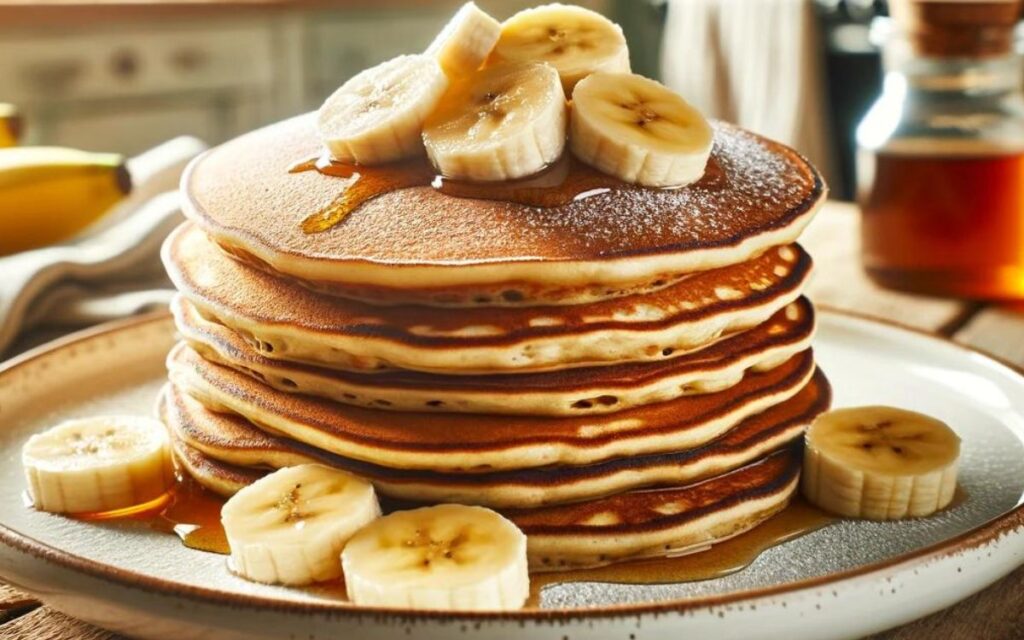
For a simple and delicious gluten-free banana pancakes recipe, you only need a few ingredients that you might already have in your kitchen. Here’s an easy-to-follow recipe:
Ingredients:
- 2 ripe bananas
- 2 eggs
- 1/2 cup of gluten-free oat flour (you can make this by blending gluten-free oats until they’re a fine powder)
- 1 teaspoon of baking powder (ensure it’s gluten-free)
- 1/2 teaspoon of vanilla extract (optional for added flavor)
- A pinch of salt
- Butter or oil for cooking
Instructions:
- Mash the Bananas: In a medium bowl, mash the ripe bananas with a fork until almost smooth.
- Mix the Batter: Crack the eggs into the bowl with the mashed bananas. Add the gluten-free oat flour, baking powder, vanilla extract (if using), and a pinch of salt. Stir until the ingredients are well combined and you have a thick batter.
- Preheat the Pan: Heat a non-stick skillet or frying pan over medium heat. Add a little butter or oil to lightly coat the bottom of the pan.
- Cook the Pancakes: Pour small rounds of batter onto the hot pan. Cook for about 2-3 minutes on one side, or until you see bubbles forming on the surface and the edges look set. Flip the pancakes carefully and cook for another 2 minutes on the other side, or until golden brown.
- Serve Warm: Serve the pancakes warm with your choice of toppings. Some great gluten-free options include fresh fruits, a drizzle of honey or maple syrup, a dollop of yogurt, or even a sprinkle of cinnamon.
This recipe is not only simple and quick to make but also nutritious and satisfying. The bananas provide natural sweetness and moisture, making the pancakes deliciously tender and flavorful without the need for added sugars or gluten-containing flours. Enjoy your gluten-free banana pancakes as a healthy breakfast or as a sweet treat any time of the day!
Quick Gluten-Free Lunch Options
When you’re in a rush but still want a nutritious and delicious lunch, try these quick gluten-free options:
- Gluten-Free Wrap with Grilled Chicken: Fill a gluten-free wrap with grilled chicken, fresh veggies, and your favorite sauce for a portable and satisfying lunch.
- Quinoa Salad with Roasted Vegetables: Prep a big batch of quinoa salad with roasted vegetables at the beginning of the week for easy grab-and-go lunches.
- Gluten-Free Pasta Salad: Toss together gluten-free pasta, cherry tomatoes, cucumber, and your choice of dressing for a refreshing and quick lunch option.
Hearty Gluten-Free Dinner Recipes
For a comforting and filling dinner, try these hearty gluten-free recipes:
- Gluten-Free Chicken Parmesan: Indulge in a classic Italian dish with a gluten-free twist. Serve it with gluten-free spaghetti and a side of steamed vegetables.
- Grilled Salmon with Quinoa and Roasted Vegetables: A healthy and flavorful dinner option that is easy to prepare and packed with nutrients.
- Gluten-Free Beef Stir-Fry: A quick and easy stir-fry loaded with vibrant veggies and tender beef, perfect for busy weeknights.
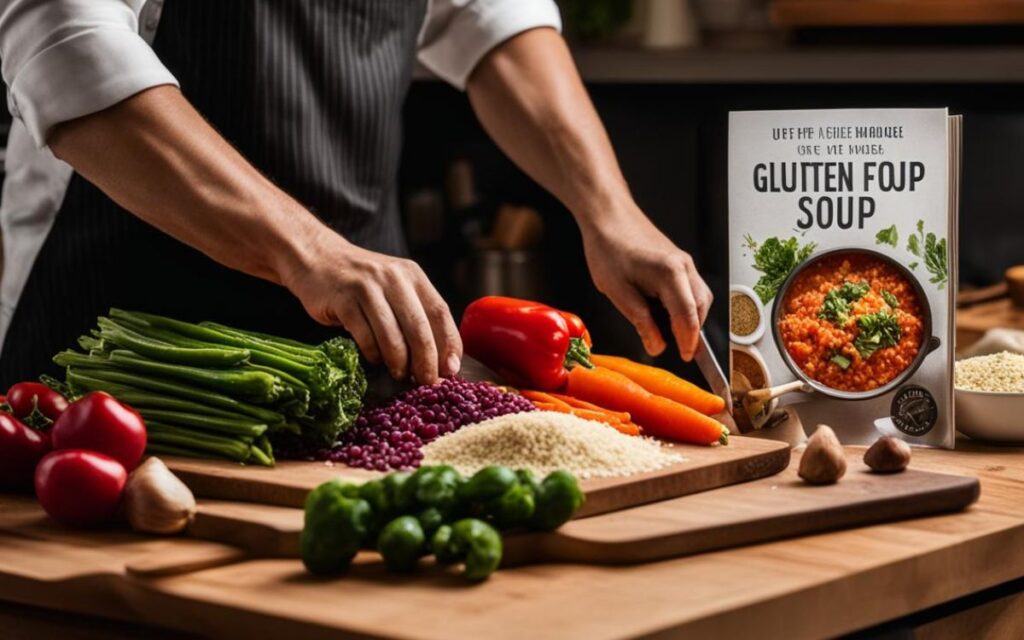
Don’t forget about snacks! Here are some gluten-free snack ideas to keep you fueled throughout the day:
- Trail mix with nuts, dried fruits, and gluten-free chocolate chips
- Apple slices with almond butter
- Rice cakes topped with avocado and sea salt
With these simple and delicious gluten-free recipes, you can enjoy a variety of meals that are both tasty and nourishing. Whether you’re a beginner or an experienced cook, these recipes are sure to impress. So grab your apron and get ready to explore the world of gluten-free cooking!
Easy Gluten-Free Meal Prep Strategies
Preparing gluten-free meals doesn’t have to be a daunting task. With a few simple strategies, you can make gluten-free meal prep easy and convenient. In this section, I will share some helpful tips to streamline your gluten-free meal planning and save time in the kitchen.
Batch Cooking and Freezer-Friendly Tips
One of the best ways to simplify gluten-free meal prep is by embracing batch cooking. By preparing large quantities of your favorite gluten-free dishes, you can save time and effort during the week. Choose a day when you have some extra time and cook up a big batch of gluten-free staples like rice, quinoa, roasted vegetables, or grilled chicken breasts. Portion them into individual containers and refrigerate or freeze them for later use.
Batch cooking not only saves time but also ensures that you always have a healthy gluten-free meal option readily available. It’s especially helpful for those busy days when you don’t have time to cook from scratch. Simply reheat your pre-cooked meals, and you’ll have a delicious and nutritious gluten-free meal in no time.
Additionally, make use of your freezer by preparing freezer-friendly meals in advance. This is particularly useful for dishes like casseroles, soups, and stews. Once cooked, portion them into individual servings, label them, and store them in the freezer. When you need a quick and easy meal, just grab a portion from the freezer, thaw, and heat it. It’s a convenient way to have homemade gluten-free meals on hand whenever you need them. Learn more about meal prep and food storage.
Economizing Time and Ingredients
When it comes to gluten-free meal prep, finding ways to economize time and ingredients can make the process more efficient and cost-effective. Here are a few tips to help you save both time and money:
- Plan your meals: Take some time at the beginning of the week to plan your gluten-free meals. This will help you make a comprehensive shopping list and avoid last-minute decisions.
- Reuse ingredients: Look for ways to repurpose ingredients throughout the week. For example, if you roast a whole chicken one night, use the leftovers to make chicken salad or add it to a stir-fry the next day.
- Shop smart: Take advantage of sales and discounts on gluten-free ingredients. Buy in bulk when possible to save money in the long run.
- Prepare ingredients ahead of time: Chop vegetables, pre-cook grains, and marinate proteins in advance. This will save you time during the actual meal prep process.
- Minimize food waste: Use leftover ingredients creatively in other meals. For example, leftover cooked vegetables can be added to omelets or salads.
By implementing these economical strategies, you can make the most of your time, ingredients, and budget while still enjoying delicious gluten-free meals.
Gluten-Free Baking Basics
When it comes to gluten-free baking, understanding the essential ingredients and having simple recipes on hand can make the process much easier. In this section, I will guide you through the basics of gluten-free baking, including the key ingredients you need and a few beginner-friendly recipes to get you started.
Essential Gluten-Free Baking Ingredients
When baking without gluten, it’s important to have the right ingredients to achieve the desired texture and flavor. Here are some essential gluten-free baking ingredients:
- Gluten-Free Flour: Look for a blend of gluten-free flours such as rice, tapioca, and potato starch. This will mimic the texture of traditional all-purpose flour without gluten.
- Xanthan Gum: This additive helps bind the ingredients together in gluten-free baked goods.
- Baking Powder: Make sure to use gluten-free baking powder to ensure your recipes rise properly.
- Baking Soda: Like baking powder, make sure your baking soda is gluten-free.
- Alternative Sweeteners: Opt for natural sweeteners like honey, maple syrup, or coconut sugar to replace traditional refined sugar.
- Dairy-Free Milk: If you’re also avoiding dairy, choose dairy-free milk like almond, coconut, or oat milk.
- Eggs: Eggs are commonly used in gluten-free baking for moisture and structure. If you are vegan or allergic to eggs, there are egg substitutes available.
- Vanilla Extract: Use gluten-free vanilla extract to add flavor to your baked goods.
Simple Gluten-Free Baking Recipes
Now that you have the essential ingredients, let’s dive into a few simple gluten-free baking recipes:
- Gluten-Free Banana Bread: Mash ripe bananas and combine them with gluten-free flour, eggs, sugar, and a touch of cinnamon. Bake until golden brown for a moist and delicious treat.
- Flourless Chocolate Cake: Made with almond flour, cocoa powder, sugar, and eggs, this decadent chocolate cake is rich and gluten-free.
- Gluten-Free Blueberry Muffins: Mix gluten-free flour, baking powder, sugar, eggs, dairy-free milk, and fresh blueberries to create fluffy and fruity muffins.
Preventing Burnout with Varied Gluten-Free Meal Ideas
When following a gluten-free diet, it’s important to keep your meals exciting and diverse to prevent burnout. By exploring global gluten-free cuisines and adding variety to your meal prepping, you can keep things interesting and enjoyable.
Exploring Global Gluten-Free Cuisines
One of the best ways to prevent burnout is to experiment with different global gluten-free cuisines. Each culture has its own unique flavors and ingredients that can add excitement to your meals. Whether it’s the bold spices of Mexican cuisine, the fragrant herbs of Thai dishes, or the comforting flavors of Italian pasta alternatives, there’s a wide range of gluten-free options to explore.
By incorporating global gluten-free cuisines into your meal planning, you’ll not only introduce new flavors and textures but also expand your culinary horizons. This can make your gluten-free journey much more enjoyable and sustainable in the long run.
Adding Diversity to Your Gluten-Free Meal Prepping
Adding diversity to your gluten-free meal prepping can be as simple as trying new recipes and incorporating a variety of gluten-free ingredients. Here are a few tips to help you add diversity to your gluten-free meal planning:
- Experiment with different gluten-free grains like quinoa, millet, and amaranth to add variety to your meals.
- Incorporate a wide range of vegetables, both cooked and raw, to ensure you’re getting a good mix of nutrients and flavors.
- Explore different protein sources such as beans, lentils, tofu, and seafood to keep your meals balanced and satisfying.
- Try new cooking techniques and flavors to keep things interesting. Roasting, grilling, and stir-frying can bring out different textures and flavors in your gluten-free dishes.
- Don’t be afraid to experiment with sauces, dressings, and spices to add depth and complexity to your meals.
By incorporating these tips into your gluten-free meal prepping, you’ll be able to enjoy a varied and diverse diet that keeps you excited about your meals.
Dairy-Free and Gluten-Free Meal Solutions
For individuals following a dairy-free and gluten-free diet, finding meal solutions that meet their dietary restrictions can be challenging. However, with some creativity and knowledge of dairy-free substitutes, it is possible to enjoy delicious and nutritious meals without compromising on taste. Whether you are lactose intolerant or have a dairy allergy, these ideas will help you navigate your gluten-free journey and provide a tasty alternative to traditional dairy-based dishes.
Ideas for Lactose Intolerant Gluten-Free Individuals
If you are lactose intolerant and following a gluten-free diet, it’s important to find dairy-free alternatives that can provide the creaminess and richness you desire. Here are some dairy-free substitutes to consider:
- Coconut milk: Use coconut milk as a substitute for cream in soups, curries, and desserts. It adds a subtle sweetness and a creamy texture.
- Almond milk: Almond milk can be used as a replacement for cow’s milk in baking recipes and for making dairy-free smoothies and shakes.
- Cashew cheese: Cashew cheese is a dairy-free alternative that can be used in place of regular cheese in recipes like macaroni and cheese or as a topping for pizzas.
- Plant-based yogurts: There are several dairy-free yogurts available on the market made from sources like almond milk, coconut milk, or soy milk. These can be enjoyed on their own or used in recipes that call for yogurt.
By incorporating these dairy-free substitutes into your gluten-free meals, you can enjoy a wide variety of dishes without sacrificing flavor or texture.
Combining Gluten and Dairy Restrictions Deliciously
If you have both gluten and dairy restrictions, it may seem challenging to find meals that meet both dietary needs. However, with some creativity and a focus on whole foods, it is possible to combine these restrictions and still enjoy delicious meals. Here are some tips to help you combine gluten and dairy restrictions:
- Focus on naturally gluten-free and dairy-free ingredients: Incorporate plenty of fruits, vegetables, lean proteins, and gluten-free grains like quinoa and brown rice in your meals.
- Experiment with gluten-free flours: There are many gluten-free flours available, such as almond flour, coconut flour, and rice flour, that can be used in place of wheat flour in baking recipes.
- Use dairy-free alternatives: Experiment with dairy-free milk, yogurt, and cheese substitutes to replace dairy products in your favorite recipes.
- Explore international cuisines: Many international cuisines naturally feature gluten-free and dairy-free dishes. Look for recipes from cuisines like Thai, Mexican, or Indian that can accommodate both restrictions.
By combining gluten and dairy restrictions creatively, you can create a wide variety of flavorful and satisfying meals that adhere to your dietary needs.
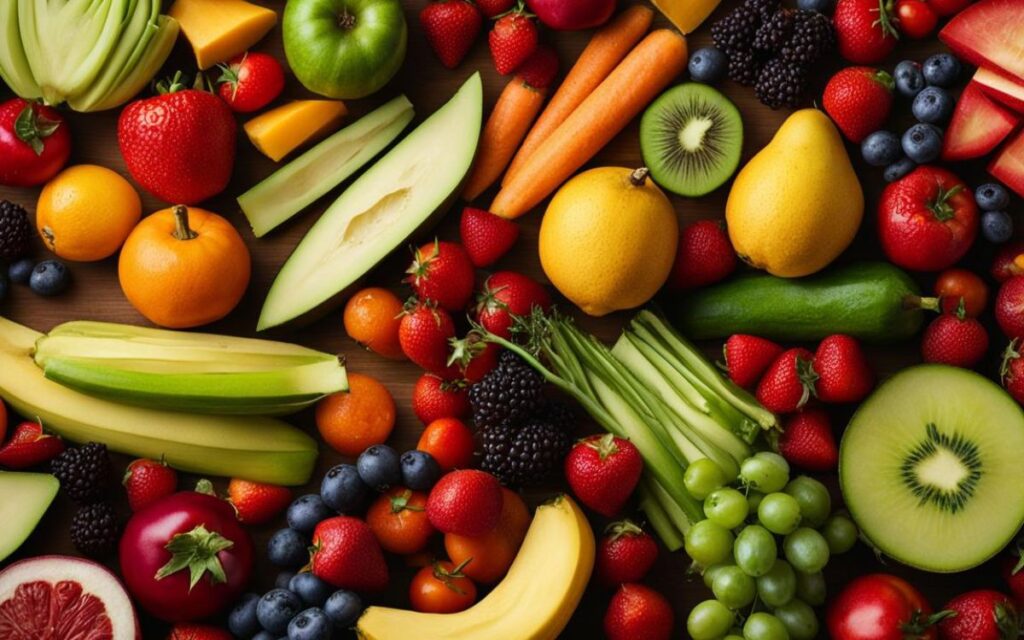
Making Gluten-Free Meal Prep Convenient
When it comes to gluten-free meal prep, convenience is key. Luckily, there are options available that can make the process even easier. In this section, we will explore two ways to make gluten-free meal prep more convenient: gluten-free meal delivery services and pre-made gluten-free meal options.
Gluten-Free Meal Delivery Services
One way to simplify your gluten-free meal prep is by utilizing a gluten-free meal delivery service. These services offer a variety of gluten-free meals that are pre-portioned, pre-packaged, and delivered right to your doorstep. With a gluten-free meal delivery service, you can enjoy the convenience of having healthy and delicious gluten-free meals ready to eat with minimal effort.
By subscribing to a gluten-free meal delivery service, you can save time on meal planning, grocery shopping, and meal preparation. These services usually offer a range of menu options, allowing you to choose meals that suit your dietary preferences and restrictions. Whether you follow a vegan, paleo, or other specific diet, there are gluten-free meal delivery services that can cater to your needs.
Additionally, gluten-free meal delivery services often use high-quality ingredients and prioritize food safety, which can provide peace of mind for those with gluten intolerance or celiac disease. These services may also offer customization options, allowing you to modify meals to suit your preferences or dietary restrictions.
Overall, utilizing a gluten-free meal delivery service can be a convenient solution for individuals who want to enjoy gluten-free meals without the hassle of planning, shopping, and cooking.
Pre-made Gluten-Free Meal Options
Another convenient option for gluten-free meal prep is to take advantage of pre-made gluten-free meals available in stores or online. These meals are pre-cooked and packaged, making them quick and easy to heat up and enjoy.
Pre-made gluten-free meals come in a variety of options, including frozen entrees, ready-to-eat salads, and grab-and-go snacks. They often feature a diverse range of cuisines and flavors, ensuring that you can find something to suit your tastes.
By having pre-made gluten-free meals on hand, you can save time and effort in the kitchen while still enjoying delicious and nutritious gluten-free meals. These meals are also convenient for individuals on the go, as they can be easily packed for lunches at work or enjoyed during travel.
When choosing pre-made gluten-free meals, it’s important to read the labels carefully to ensure they meet your dietary needs. Look for meals that are certified gluten-free and free from any cross-contamination risks. If you have other dietary restrictions, such as being dairy-free or vegan, be sure to choose meals that align with those requirements as well.
Overall, incorporating pre-made gluten-free meals into your meal prep routine can provide convenience and variety, ensuring that you always have a delicious gluten-free meal option available when you need it.
Staying Gluten-Free On-the-Go
When following a gluten-free diet, it’s important to maintain your dietary needs even when eating out or on-the-go. Here are some tips to help you stay gluten-free and enjoy your meals:
Gluten-Free Eating Out Tips
- Research gluten-free options: Before heading out, check online for restaurants that offer gluten-free menus or have gluten-free options. This will make it easier to find suitable choices.
- Call ahead: If you’re unsure about a restaurant’s gluten-free offerings, give them a call in advance. Ask about their gluten-free practices, cross-contamination prevention, and any specific gluten-free dishes they offer.
- Ask questions: When dining out, don’t be afraid to ask questions about ingredients, food preparation methods, and potential cross-contamination risks. Open communication with the staff will help ensure your meal is gluten-free.
- Be cautious with sauces and dressings: Many sauces and dressings contain gluten. Ask for gluten-free alternatives or request dressings and sauces on the side, so you can control the amount you consume.
- Choose naturally gluten-free options: Opt for dishes that are naturally gluten-free, such as grilled meats, seafood, vegetables, and salads. These options are less likely to have hidden sources of gluten.
- Be mindful of cross-contamination: Even if a restaurant offers gluten-free options, cross-contamination can still occur. Make sure to inform the staff about the severity of your gluten intolerance and ask them to take extra precautions to avoid cross-contamination.
Reading Gluten-Free Food Labels
Reading food labels is crucial when maintaining a gluten-free diet. Here are some tips to help you navigate gluten-free food labels:
- Look for “gluten-free” certifications: Some products are certified gluten-free by third-party organizations. Look for labels or logos that indicate a product meets strict gluten-free standards.
- Read ingredient lists carefully: Check the ingredient list for common sources of gluten, such as wheat, barley, rye, and oats. Also, watch out for hidden sources of gluten, such as malt, modified food starch, and hydrolyzed vegetable protein.
- Beware of cross-contamination statements: Manufacturers are required to disclose if their products are processed in facilities that also handle gluten-containing ingredients. Look for statements like “May contain traces of gluten” or “Manufactured in a facility that processes wheat.”
- Use gluten-free apps and resources: There are smartphone apps and online resources available that can help you quickly determine if a product is gluten-free. These resources often provide information on safe brands and specific product recommendations.
By following these tips and staying vigilant about gluten-free eating out and reading food labels, you can confidently enjoy meals outside of your home without compromising your gluten-free diet.

Conclusion
In conclusion, this gluten-free meal prep guide provides beginners with all the essential information for starting a gluten-free meal plan. We have explored the benefits of gluten-free meal planning and discussed the challenges of navigating gluten intolerance and celiac disease.
Understanding the fundamentals of a gluten-free kitchen, such as setting up a gluten-free pantry and preventing cross-contamination, is crucial in maintaining a safe and healthy gluten-free lifestyle.
Throughout this guide, I have shared practical tips and strategies to help beginners succeed in gluten-free meal prep. Building a well-planned gluten-free grocery list and creating a balanced diet plan is essential for enjoying a variety of nutrient-rich meals. I have also provided a collection of simple and delicious gluten-free recipes suitable for breakfast, lunch, dinner, and snacks.
Whether you are looking to save time with easy meal prep strategies, explore global gluten-free cuisines, or cater to specific dietary needs such as dairy-free or vegan, this guide has covered it all.
Additionally, I have highlighted convenient options like gluten-free meal delivery services and pre-made meal options. With the knowledge gained from this guide, you can confidently navigate gluten-free eating when dining out and easily decipher gluten-free food labels to make informed choices.
Don’t forget to check out my Meal Prep for Beginners Guide article.
FAQ
What is a gluten-free diet?
A gluten-free diet is one that eliminates the protein gluten found in wheat, barley, and rye. It is necessary for individuals with celiac disease or gluten intolerance to avoid consuming gluten to prevent adverse health effects.
What are the benefits of gluten-free meal planning?
Gluten-free meal planning can help improve digestive health, reduce symptoms for those with gluten intolerance or celiac disease, promote balanced nutrition, increase energy levels, and support overall well-being.
How do I navigate gluten intolerance and celiac disease?
If you suspect you have gluten intolerance or celiac disease, it is essential to consult with a healthcare professional for a proper diagnosis. They can provide guidance on managing your condition and offer advice on following a gluten-free diet.
How do I set up a gluten-free pantry?
To set up a gluten-free pantry, stock up on gluten-free grains like rice, quinoa, and oats, as well as gluten-free flours, baking mixes, and pasta. Make sure to label and store them separately from gluten-containing ingredients to prevent cross-contamination.
How can I prevent cross-contamination in my kitchen?
To prevent cross-contamination, ensure that all kitchen surfaces, utensils, and cookware are thoroughly cleaned before preparing gluten-free meals. Use separate cutting boards and designate specific gluten-free cooking tools to avoid any contact with gluten-containing ingredients.
How do I plan and prepare gluten-free meals in advance?
To plan and prepare gluten-free meals in advance, start by creating a weekly meal plan and grocery shopping list. Cook in batches and portion out meals into individual containers for easy grab-and-go options throughout the week.
Can you recommend any easy gluten-free recipes for beginners?
Some easy gluten-free recipes for beginners include quinoa stir-fry, roasted chicken with vegetables, gluten-free pasta with marinara sauce, and baked salmon with quinoa and roasted vegetables.
What gluten-free ingredients are essential for a well-stocked pantry?
Essential gluten-free ingredients for a well-stocked pantry include gluten-free flours (such as almond or coconut flour), gluten-free pasta, quinoa, rice, gluten-free baking mixes, gluten-free soy sauce, and gluten-free oats.
How can I find gluten-free substitutes for common ingredients?
There are many gluten-free substitutes available for common ingredients. For example, you can use gluten-free flour blends in place of all-purpose flour and coconut milk or almond milk instead of regular dairy milk.
How do I incorporate whole foods into my gluten-free meal plan?
To incorporate whole foods into your gluten-free meal plan, focus on fresh fruits and vegetables, lean proteins like chicken and fish, and whole grains like quinoa and brown rice. Limit processed foods and opt for whole, natural ingredients whenever possible.
Are there gluten-free options for vegans?
Yes, there are plenty of gluten-free options for vegans. Some examples include tofu, tempeh, beans, lentils, fruits, vegetables, nuts, seeds, gluten-free grains, and plant-based milk alternatives. Here is an article about vegan meal prep for beginners.
What are some easy gluten-free breakfast ideas?
Easy gluten-free breakfast ideas include overnight chia seed pudding, gluten-free oats with fresh fruit and nuts, scrambled eggs with vegetables, and gluten-free toast with almond butter and banana.
Can you suggest quick gluten-free lunch options?
Quick gluten-free lunch options include salads with grilled chicken or shrimp, quinoa bowls with roasted vegetables, gluten-free wraps or sandwiches with deli meat and vegetables, and homemade gluten-free soups.
What are some hearty gluten-free dinner recipes?
Hearty gluten-free dinner recipes include gluten-free pasta with marinara and meatballs, grilled steak or salmon with roasted potatoes and vegetables, cauliflower fried rice, and chicken or vegetable stir-fry with gluten-free soy sauce.
How can I save time with gluten-free meal prep?
To save time with gluten-free meal prep, try batch cooking larger quantities of meals that can be divided into individual servings and frozen for later use. Utilize slow cookers and pressure cookers for hands-off cooking.
What are some essential ingredients for gluten-free baking?
Essential ingredients for gluten-free baking include gluten-free flour blends, almond flour, coconut flour, baking powder, baking soda, xanthan gum (a binding agent), and alternative sweeteners like honey or maple syrup.
How can I prevent burnout with gluten-free meal ideas?
To prevent burnout with gluten-free meal ideas, explore cuisines from around the world that naturally have gluten-free dishes, such as Mexican, Thai, and Indian. Experiment with spices, flavors, and textures to keep your meals exciting and diverse.
What are some meal solutions for those who are dairy-free and gluten-free?
Meal solutions for those who are dairy-free and gluten-free include using dairy-free alternatives like coconut milk or almond milk in recipes, experimenting with dairy-free cheeses, and incorporating plant-based proteins like tofu or tempeh.
Are there gluten-free meal delivery services available?
Yes, there are gluten-free meal delivery services that offer pre-made, ready-to-eat gluten-free meals. These services provide convenient options for individuals who want to follow a gluten-free diet without the hassle of meal prepping.
How can I stay gluten-free when eating out?
To stay gluten-free when eating out, research restaurants in advance that offer gluten-free options. Choose dishes made with naturally gluten-free ingredients and inform your server about your dietary restrictions to ensure your meal is prepared safely.
How do I read gluten-free food labels?
When reading gluten-free food labels, look for the certified gluten-free symbol or read the ingredient list for any potential sources of gluten. Avoid foods that contain wheat, barley, rye, or any ingredients derived from these grains.

Jim Lopez, the founder and editor of The Meal Prep Ninja, shares his journey from a passionate bodybuilder and fitness enthusiast to a certified nutrition coach. Certified by Precision Nutrition, Jim aims to empower others with knowledge on meal prep and nutrition, offering resources for busy individuals to enjoy low-calorie, tasty foods. His blog is a community for sharing healthy eating habits and meal prep recipes
